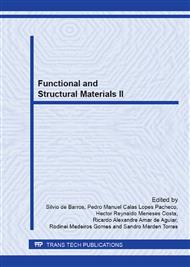[1]
I.W. Bang, Y.P. Son, K.H. OH, Y.O. Kim and W.S. Kim: Welding Journal (2002), pp.273-282.
Google Scholar
[2]
T. Teng and P. Chang: Journal of Materials Processing Technology Vol. 145(2004), pp.325-335.
Google Scholar
[3]
H.R.M. Costa, M.M. Lemos, P.M.C.L. Pacheco and R.A.A. Aguiar, Finite Element Analysis of Multipass Welded Steel Plates, COBEM 2007 - 19th International Congress of Mechanical Engineering, Brasília, Brazil (2007).
Google Scholar
[4]
T. Zacharia, J.M. Vitek, J.A. Goldak, T.A. Debroy, M. Rappaz and H.K.D.H. Bhadeshia: Modeling Simul. Mater. Sci. Eng. Vol. 3 (1995), pp.265-288.
DOI: 10.1088/0965-0393/3/2/009
Google Scholar
[5]
B. Taljat, B. Radhakrishnan and T. Zacharia: Mat. Science and Eng., Vol. A246 (1998), pp.45-54.
Google Scholar
[6]
J. Ronda and G.J. Oliver: Comput. Methods Appl. Mech. Eng. Vol.189 (2000), pp.361-417.
Google Scholar
[7]
R.M.B. Silva and P.M.C.L. Pacheco: Modeling Residual Stresses in Welded Steel Plates Using a Constitutive Model With Phase Transformation, COBEM 2005 – 18th International Congress of Mechanical Engineering, Ouro Preto, Brazil (2005).
Google Scholar
[8]
R.M.B. Silva and P.M.C.L. Pacheco: On the Thermomechanical Coupling Effects in the Welding of Steel Plates using a Constitutive Model, COBEM-2007, 19th International Congress of Mechanical Engineering, Brasília, Brazil (2007).
Google Scholar
[9]
E.P. Silva, P.M.C.L. Pacheco and M.A. Savi: Int. J. of Solids and Struct. Vol. 41 n.3-4 (2004), pp.1139-1155.
Google Scholar
[10]
E.P. Silva, P.M.C.L. Pacheco and M.A. Savi: Journal of Strain Analysis for Engineering Design Vol. 40 n. 2 (2005),. pp.151-160.
Google Scholar
[11]
R.M.B. Silva, P.M.C.L. Pacheco, W.P. Oliveira and M.A. Savi : Modeling Residual Stresses in Welded Steel Plates Using A Constitutive Model With Diffusional Phase Transformations, CILAMCE 2005 – XXVI Iberian Latin-American Congress on Computational Methods in Engineering, Espírito Santo, Brazil (2005).
Google Scholar
[12]
R.M.B. Silva: A Contribution to the Modeling the Welding Process of Steel Plates Using a Coupled Constitutive Model, M.Sc. Dissertation, Mestrado em Tecnologia - CEFET/RJ, in Portuguese (2007).
Google Scholar
[13]
G.E. Linnert, Welding Metallurgy - Carbon and Alloy Steels", 3rd edition, American Welding Society (1997).
Google Scholar
[14]
H.T. Kanga, Y.-L. Leeb and X.J. Sun: Materials Science and Engineering A Vol. 497 (2007), p.37–43.
Google Scholar
[15]
Z. Pavelic, R. Tanbakuchi, O.A. Uyehara and P.S. Meyers: Welding Journal Research Supplement Vol. 48 (1969), p.295–305.
Google Scholar
[16]
J. Goldak, A. Chakravarti, and M. Bibby: Metallurgical Transactions B Vol. 15b (1984), p.299–305.
Google Scholar
[17]
E. Friedman: Jounal of Pressure Vessel Technology - Trans ASME Vol.97 (1975), pp.206-213.
Google Scholar
[18]
F. Rezende: Welding Residual Stresses Analysis in Superduplex Stainless Steel UNS 32750: Experimental and Numerical Analysis, M.Sc. Dissertation, Mestrado em Eng. Mecânica e Tecnologia de Materiais - CEFET/RJ, in Portuguese (2011).
Google Scholar
[19]
ANSYS, Ansys Manual, Release 12, Ansys Inc (2010).
Google Scholar
[20]
W.P. Oliveira: Modeling Quenching Process in Steel Cylinder Using Multi-Phase Constitutive Model, M.Sc. Dissertation, Mestrado em Tecnologia - CEFET/RJ, in Portuguese (2004).
Google Scholar
[21]
R.N. Gunn, Duplex stainless steels. Microstructure, properties and applications, Cambridge, Abington Pub. (2003).
Google Scholar
[22]
IMOA, The International Molybdenum Association (IMOA). Practical Guidelines For The Fabrication of Duplex Stainless Steels, London - UK, 64 p. (2009).
Google Scholar
[23]
Sandvik, Material Datasheet S-23705-ENG/S-23812-ENG, Sandvik, (2007).
Google Scholar
[24]
B. Brickstad and B.L. Josefson: International Journal of Pressure Vessels and Piping Vol. 75 (1998), pp.11-25.
Google Scholar
[25]
ASM, Metals Handbook Volume 8, ASM International, 8th Edition (1966).
Google Scholar
[26]
ASTM, E 837-08 - Standard Test Method for Determining Residual Stresses by the Hole-Drilling Strain-Gage Method, ASTM (2008).
DOI: 10.1520/e0837-01e01
Google Scholar
[27]
H. Purmohamad, A. Kermanpour and M. Shamanian, Numerical Simulation and Experimental Investigation of Residual Stress in the Circumferential Butt GTAW of Incoloy 800H Pipes, ASM International (2008).
DOI: 10.1007/s11665-009-9391-0
Google Scholar
[28]
A.H. Yaghi, T.H. Hyde, A.A. Becker and W. Sun: Finite Element Simulation of Welding and Residual Stresses in a P91 Steel Pipe Incorporating Solid-State Phase Transformation and Post-Weld Heat Treatment, IMech (2008).
DOI: 10.1243/03093247jsa372
Google Scholar


